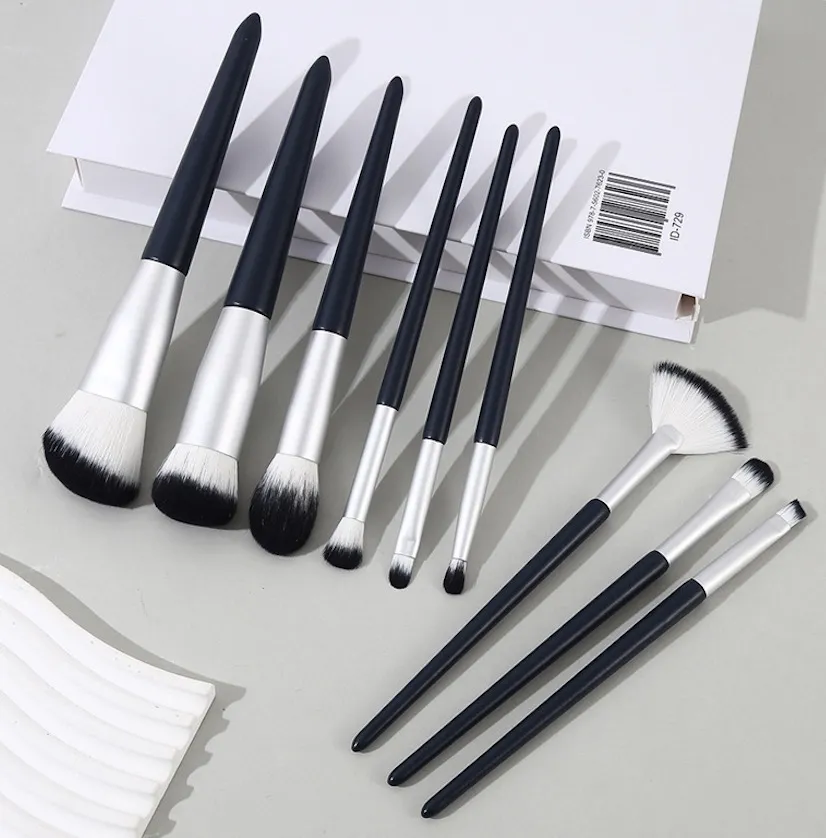Sourcing makeup brush sets1 feels overwhelming. You worry about choosing the wrong brushes, materials, or supplier, and that a bad decision will cost you money and damage your brand’s reputation.
A good makeup brush set should include 5–7 essentials: a foundation or kabuki brush, powder, blush/contour, flat eyeshadow, crease/blending, and an eyeliner/brow brush. Choose synthetic bristles2 for liquids and creams, and high-performance synthetics for powders to balance performance, ethics, and durability.

When I first started on the factory floor, I saw firsthand how small details in a brush set could make or break a brand’s launch. The difference between a bestseller and a box of returns often comes down to asking the right questions before you place an order. It’s not just about finding a supplier; it’s about finding a partner who understands your vision for quality, compliance, and customer experience. Let’s walk through the four most critical areas you need to investigate to build a brush set that not only looks beautiful but performs flawlessly and drives sales.
The global makeup brush market is projected to decline by 2030 due to the rise of disposable applicators.False
Market data from multiple sources like GMI and Dataintelo shows a consistent compound annual growth rate (CAGR) of around 5-6%, indicating steady market growth, not decline.
Synthetic brush fibers have evolved to match the performance of natural hair for powder application.True
Modern synthetic fibers are engineered with ultra-fine, tapered tips that mimic the texture and pickup capabilities of natural animal hair, offering a high-performance, ethical alternative.
Set Architecture: How many brushes do customers actually need—and which ones convert best?
You see massive 20-piece sets and tiny 3-piece kits online. It’s confusing to know which size is right for your brand. If you choose wrong, you either overwhelm customers with redundant brushes or underwhelm them with a set that isn’t functional.
For most consumer brands, the sweet spot is a core set of 5–7 brushes. This covers daily use without causing confusion. Pro or comprehensive sets can scale to 12–20+ pieces, but you must avoid redundancy to protect your margins and customer satisfaction.
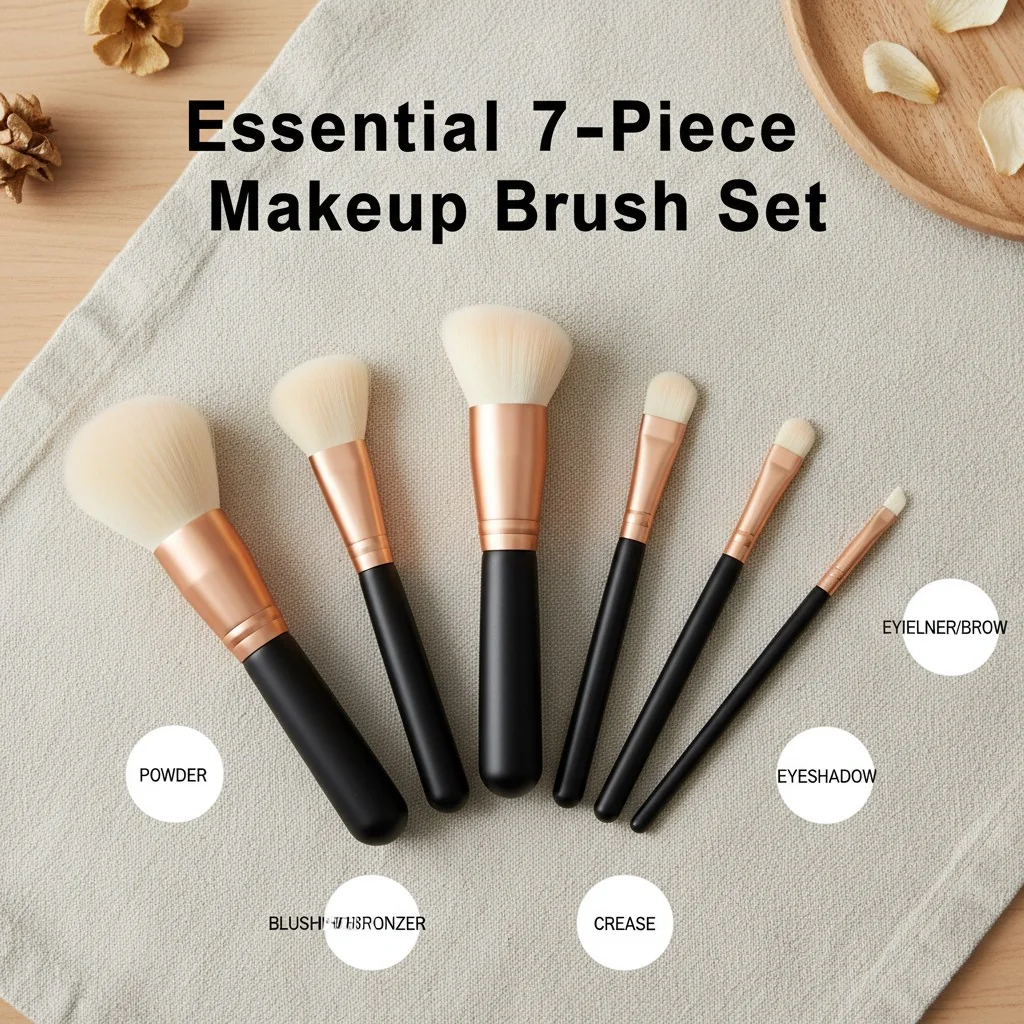
From my experience helping hundreds of brands, I can tell you that over-stuffed sets with repetitive shapes actually lead to worse reviews and higher return rates. Customers get confused and feel they didn’t get their money’s worth. The key is to build a functional, intuitive kit.
The Core Set That Sells
A starter set should always include these essentials:
- Foundation or Kabuki Brush: For liquid or cream base application.
- Powder Brush: A large, fluffy brush for setting powder.
- Blush/Contour Brush: An angled or tapered brush for cheeks.
- Flat Eyeshadow Brush: For packing color onto the lid.
- Crease/Blending Brush: A fluffy brush for blending eyeshadow in the crease.
- Eyeliner/Brow Brush: A small, angled brush for precision.
A Smarter Way to Scale
Instead of one giant set, think modular. Offer a "Core Face Set" and then sell an "Advanced Eye Detail Set" or a "Pro Complexion Kit" separately. This strategy encourages customers to add on to their collection over time, increasing their lifetime value (LTV) without forcing them to buy duplicates. It also simplifies your inventory and makes your product line feel more curated and professional.
A 20-piece brush set is the best option for beginners.False
Beginners are often overwhelmed by large sets with redundant brushes. A curated 5-7 piece set with clearly defined functions provides a better user experience and is more likely to receive positive reviews.
Offering modular brush sets, like a core kit and separate add-on kits, can increase a customer's lifetime value (LTV).True
This strategy encourages repeat purchases as customers expand their collection, building brand loyalty and increasing the total revenue generated from a single customer over time.
Materials & Claims: Synthetic vs. natural, antimicrobial fibers, and cruelty‑free labeling for EU/US?
Natural or synthetic? Vegan? Antimicrobial? The material claims are endless and can be very confusing. Making the wrong choice can lead to compliance issues in your target market, alienate your customers, or simply result in a poor-performing product.
Choose synthetic bristles for their compatibility with liquid and cream formulas and their strong ethical positioning. For powder performance, modern natural-like synthetics are an excellent choice. If you must use natural hair, limit it to powder tools and be transparent about sourcing.
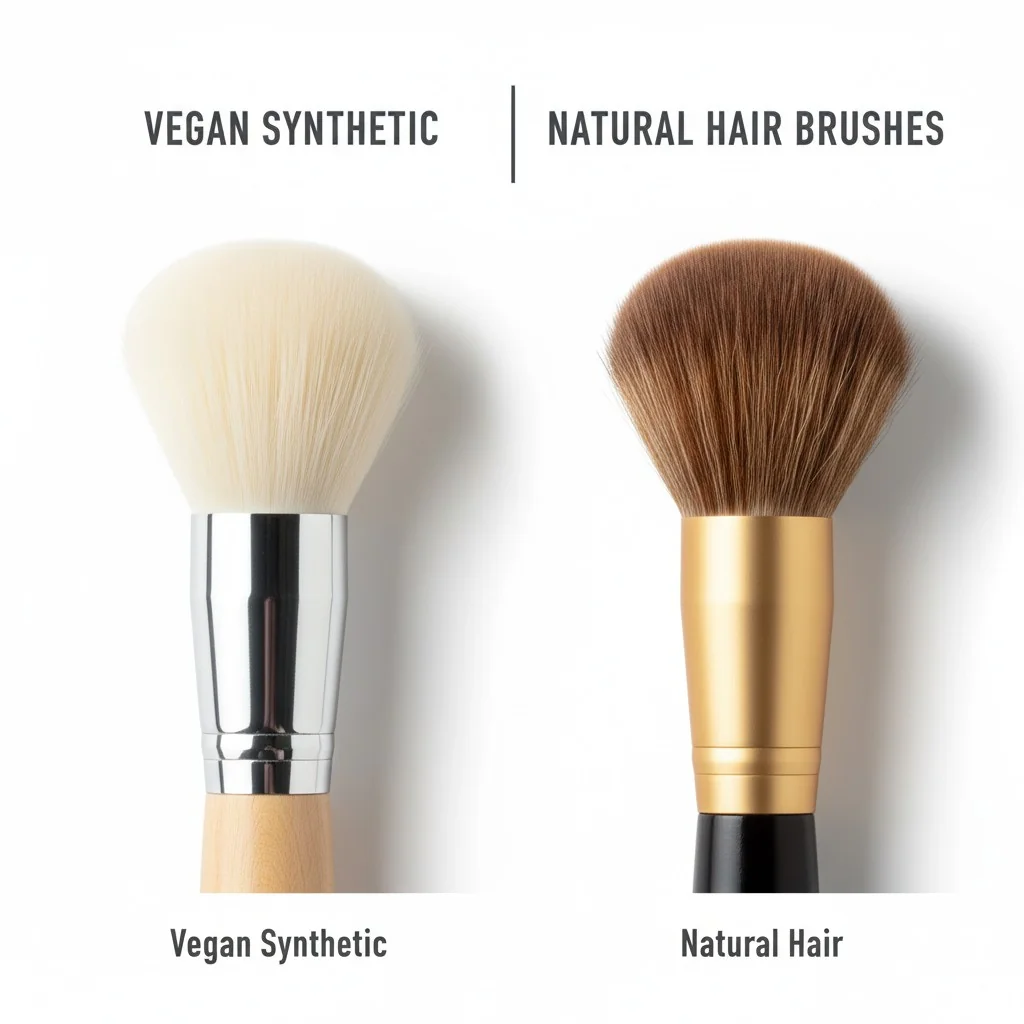
The debate between synthetic and natural hair used to be simple: natural was for powders, synthetic for liquids. But technology has changed everything. Today, the decision is more strategic. Mainstream markets in the US and EU increasingly demand vegan and cruelty-free products. High-performance synthetic fibers now offer the same softness and powder pickup as natural hair, but without the ethical and sourcing headaches.
Decoding the Claims
- Synthetic vs. Natural: Synthetic bristles are less porous, so they don’t absorb liquid and cream products. This means less product waste and a smoother application. While natural hair is still prized for how it diffuses powder, the performance gap has closed significantly. For a modern brand, a single-fiber line using only advanced synthetics is the smartest path forward.
- Antimicrobial Claims: Some fibers are treated to resist bacterial growth. This can be a great marketing point, but you must be able to back it up. If a factory claims their brushes are antimicrobial, ask for the lab test reports to prove it. This protects you and your customers.
- Cruelty-Free & Vegan: These claims are powerful, but they need to be legitimate. Don’t just take a supplier’s word for it. Ask for documentation and ensure their definition aligns with recognized standards for your sales region. Ambiguous language can get you in trouble with regulators and customers.
All synthetic brushes are automatically vegan and cruelty-free.False
While the bristles are synthetic, the glue used in the ferrule or the paint on the handle could be derived from animal products. True vegan certification requires verification of all components.
Antimicrobial claims on makeup brushes must be substantiated with lab testing reports.True
Marketing claims related to health and safety, such as 'antimicrobial,' require scientific evidence to be considered valid and to avoid misleading consumers.
OEM Readiness: What about MOQ, sampling speed, and packaging that sells on DTC/Amazon?
You have a brilliant vision for your brand, but finding a factory that respects it and can work with your scale is a huge challenge. I’ve seen too many founders get discouraged by high MOQs, slow sample turnarounds, and generic packaging that kills their launch before it even starts.
A truly "OEM-ready" partner prioritizes low MOQ, fast and accurate prototyping, and offers distinctive packaging options. They should provide clear lead times and transparent pricing, with customization options that support a premium brand identity for channels like DTC and Amazon.
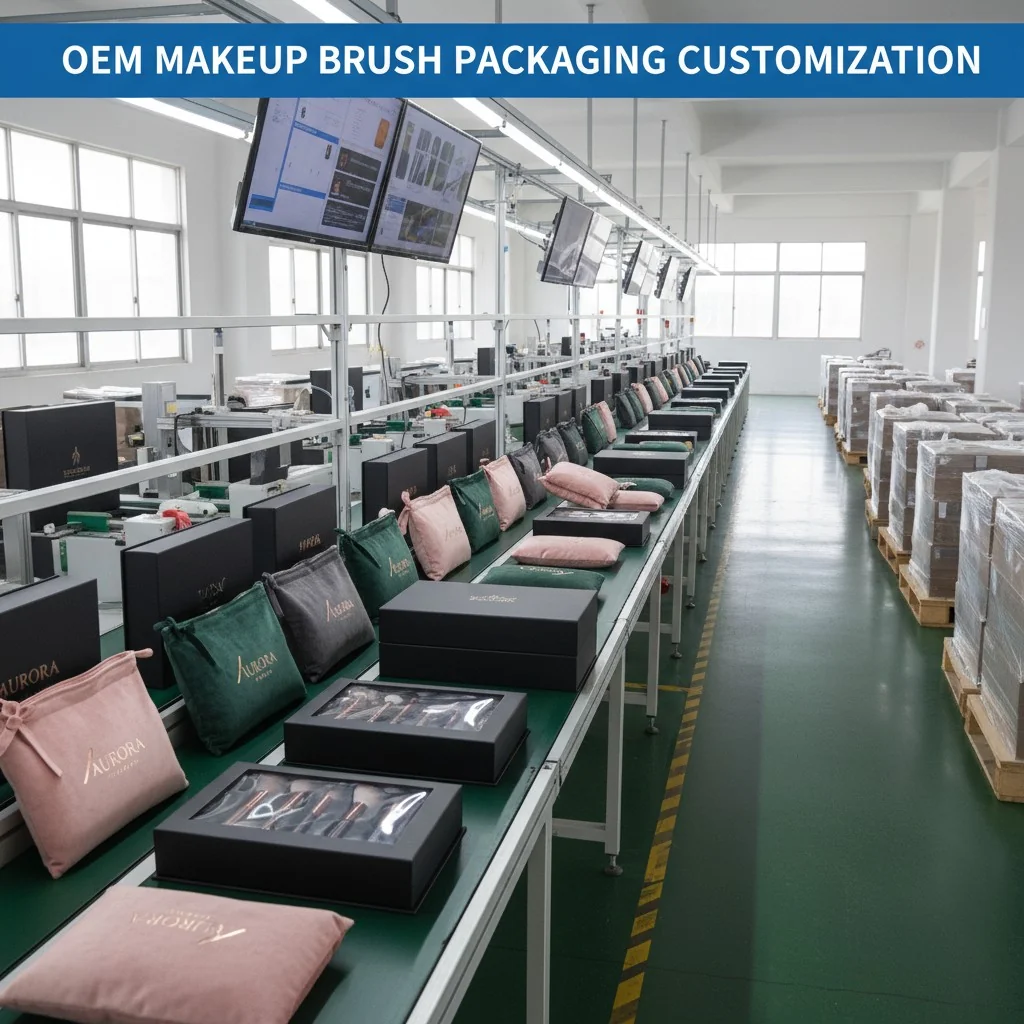
For an independent brand founder like Emily, flexibility is everything. That’s why at Brushino, we built our mission around low MOQs—to empower brands to launch without the burden of overstocking. Your factory partner should be an extension of your team, not a barrier to your growth.
Key Indicators of a Good OEM Partner
- MOQ and Sampling: Ask about the minimum order quantity3 (MOQ) upfront. A good partner will offer a reasonable number that allows you to test the market. Sampling should be fast (weeks, not months) and accurate to your design specs.
- Packaging That Converts: On Amazon and your own Shopify store, packaging is part of the product. Ask potential suppliers what they offer. Rigid boxes with foam inserts convey quality. Travel pouches add utility and perceived value. Using sustainable materials can also be a huge selling point.
- Customization: Your brushes should reflect your brand. A ready partner can customize everything: handle finishes, ferrule colors, fiber types, and logo printing methods. This is how you create a product that justifies a premium price point.
Here is a snapshot of the market you’re entering. The steady growth shows that there is plenty of opportunity for well-designed, high-quality brush sets.
| Metric | Value | Source/Year |
|---|---|---|
| Global makeup brush & tools market size | USD 7.0B (2024) | ${DIA-SOURCE} |
| Forecast CAGR (tools) | 6.3% (2025–2034) | ${DIA-SOURCE} |
| Makeup brushes market size | USD 1.5B (2023) | ${DIA-SOURCE} |
| Forecast CAGR (brushes) | 6.1% (to 2032) | ${DIA-SOURCE} |
| Cosmetic brushes market size | USD 3.72B (2024) | ${DIA-SOURCE} |
| Forecast CAGR (cosmetic brushes) | 4.91% (2025–2035) | ${DIA-SOURCE} |
All OEM factories offer free and unlimited samples to new clients.False
Most factories charge for samples to cover material and labor costs, and to filter for serious clients. Some may refund the sample fee upon placement of a bulk order.
Unique packaging design significantly impacts conversion rates for makeup brushes sold online.True
On platforms like Amazon and DTC websites, packaging is a key visual differentiator that communicates brand value, quality, and user experience before the customer even touches the product.
QC and Compliance: How do you handle QC, compliance, and certifications that reduce returns?
You’re worried about placing a huge order, only to receive a bulk shipment that doesn’t match the quality of the sample you approved. It’s a common fear. Compliance issues can get your products stopped at customs, and poor quality control4 leads directly to bad reviews and high return rates.
To protect your brand, you must work with a supplier who maintains documented ISO/QC processes, can prove compliance with regulations like REACH for the EU, and provides clear labeling. Including a simple care guide with your brushes can also dramatically reduce hygiene-related returns.
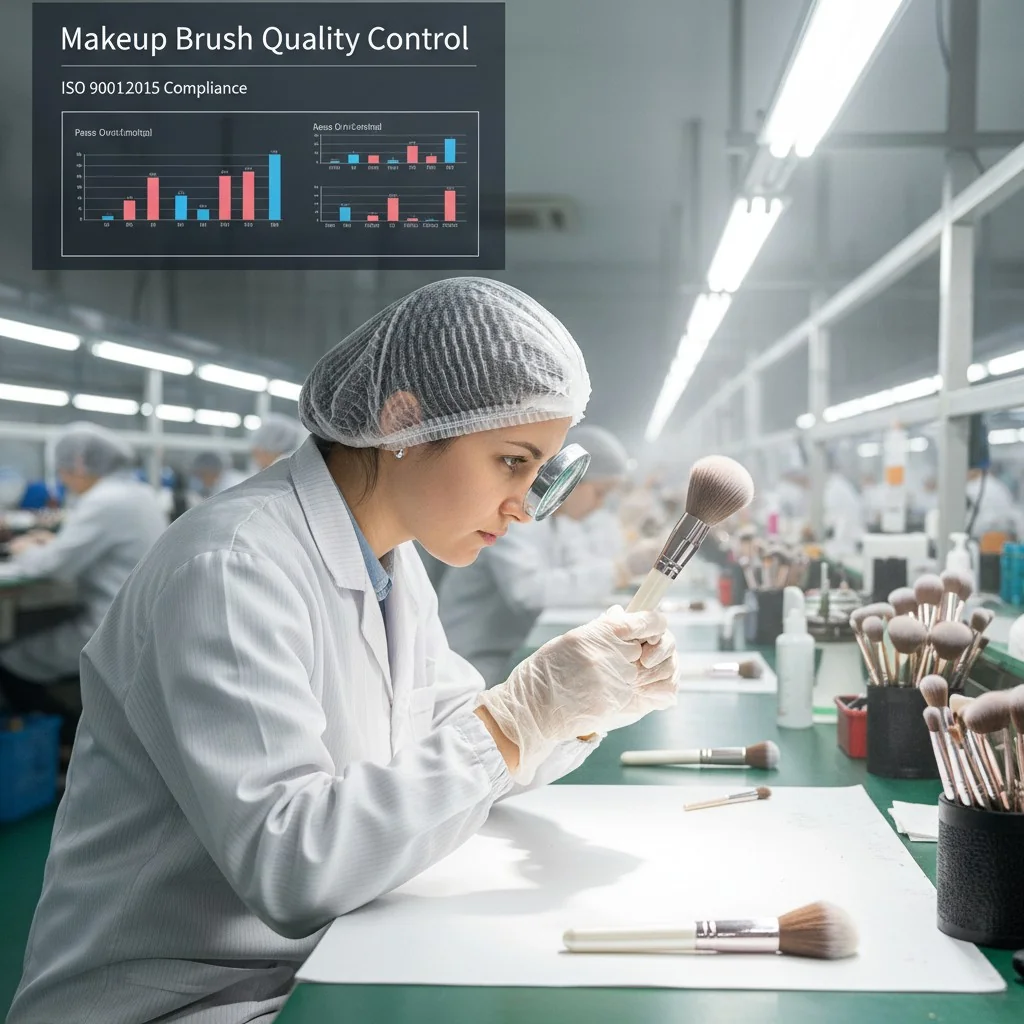
One of the biggest pain points I hear from brand founders is a lack of real documentation. A factory might say "yes, we are ISO certified" or "yes, our brushes are vegan," but they can’t produce the paperwork. This is a major red flag. A professional partner will have all their documentation ready for you because they know it’s essential for doing business in major markets.
Your Compliance Checklist
- ISO/QC Systems: Ask for a copy of their ISO 9001 certificate. This shows they have a documented quality management system. It’s a factory’s written promise to you that they have processes for maintaining consistency from the first brush to the last.
- Market-Specific Compliance: If you’re selling in Europe, your products must be REACH compliant. This regulation restricts certain chemicals. Your supplier should be able to provide a letter of compliance.
- Verifiable Certifications: For claims like "cruelty-free" or "vegan," ask for the supporting certificates from the issuing organizations. This reduces your risk and builds trust with your customers.
- Proactive Quality Control: A great way to reduce returns is to manage customer expectations. I always advise my clients to include a small "Care & Cleaning" card in their packaging. It should recommend a cleaning cadence (e.g., weekly for foundation brushes) and proper drying instructions. This simple step prevents many common complaints about shedding or ferrule damage and reinforces your brand’s commitment to quality.
A factory's website is sufficient proof of its certifications.False
Official certifications must be verified through current, valid documents issued by the certifying body. Website claims can be outdated, exaggerated, or fraudulent.
Including brush cleaning instructions with your product can help reduce customer complaints and returns.True
Many issues like bristle shedding or damage are caused by improper cleaning and drying. Educating the customer on proper care manages expectations and reduces user-error-related complaints.
Conclusion
Asking the right questions about set architecture, materials, OEM readiness5, and compliance is the key. This empowers you to source a makeup brush set that delights customers and builds your brand.
References
-
Explore the latest trends and top-rated options in makeup brush sets to enhance your beauty routine. ↩
-
Learn how synthetic bristles can improve makeup application and are a more ethical choice. ↩
-
Get insights into how MOQ affects product launches and inventory management for brands. ↩
-
Find out how effective quality control can prevent product issues and improve customer satisfaction. ↩
-
Understand the importance of OEM readiness in ensuring quality and efficiency in product manufacturing. ↩


